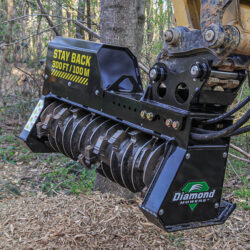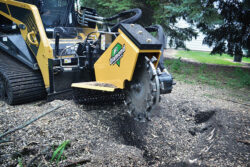
After the disaster
By Matt Nelson
Features Business IntelligenceHere’s how to prepare to help your customers in storm season.
 Advanced mulchers can chew up trees up to 14 inches in diameter – essential for clearing damaged wooded areas and preparing the ground for future growth.
All Photos: Diamond Mowers
Advanced mulchers can chew up trees up to 14 inches in diameter – essential for clearing damaged wooded areas and preparing the ground for future growth.
All Photos: Diamond Mowers July, stand by, August, come they must, September, remember, October, all over. That’s the old rhyme that told sailors when to expect hurricanes. Most of us don’t have to worry about actual hurricanes in Canada, but our season for strong storms and tornados is not much different. Here are some tips on what you need in your fleet to help customers clean up after a big blow devastates their property.
Natural disasters can leave a trail of destruction and debris in their wake that litters the landscape and creates significant issues for landowners. When clearing vegetation and trees left behind by storms, floods and forest fires, the right equipment is essential for helping return the land to its natural state.
“If your customers are in the disaster recovery business or handle storm and fire cleanup, you need equipment that can cut, shred, mulch and process downed trees, broken branches and burnt brush,” says Matt Nelson, director of development for Diamond Mowers, a manufacturer of industrial mowing, mulching and brush cutting equipment for the municipal, skid-steer, and excavator markets.
Here are some must-have tools Nelson recommends for landowners, farmers, ranchers and contractors tackling disaster cleanup, fire prevention and recovery.
Mulchers
After severe weather or fire, the land can be layered with hazardous trees and brush. Removing these hazards calls for the powerful processing and rotation speed of a disc or drum mulcher designed for large mulch and brush management applications.

Excavator-mounted drum mulchers excel at the heavier projects requiring fast removal of many damaged trees and bushes.
Engineered to act like a flywheel, the distinctive disc mulcher design combines stored energy with hydraulic power to enable operators to cut and mulch trees and brush in their path effectively and efficiently. Conversely, drum mulchers get their name from their cylindrical, drum-like shape. These heavy-duty land clearing mulchers shred small trees and brush with a forward spinning motion – a quality that makes them great for quick brush and undergrowth removal.
“By mulching downed vegetation and debris, you can return the materials and nutrients back to the ground, preparing the land for replanting and new growth,” explains Nelson.
Look for a a mulcher that is compatible with standard- and high-flow hydraulic skid-steers. Common sizes range from 48- to 60-inch cutting widths. They can slice through trees and brush up to 14 inches in diameter and shred material up to six inches in diameter. For heavy-duty land reclamation projects, excavator-mounted versions are available in 36- or 48-inch cutting widths and can process material up to 12 inches in diameter.
Drum mulchers are also usually compatible with standard- and high-flow skid-steers and excavators. These attachments can continuously mulch material up to nine inches in diameter and are available in 60- and 72-inch sizes.
“Unlike other land-clearing techniques, mulching doesn’t cause disturbance to the soil, which is vital for reducing erosion and aiding in water conservation by preventing moisture loss,” adds Nelson. “Employing a disc or drum mulcher can improve soil fertility and deliver essential nutrients that will serve future vegetation.”
Stump grinders
Another must-have piece of equipment for anyone involved in disaster cleanup and prevention is a stump grinder. Essential for removing stumps after trees have been broken, burnt or carried away by fierce winds, fire or flooding, this tool uses a rotating cutting disc that mulches stumps into small pieces. There are two main styles.

After the trees are removed, your customers may to need to take out the stumps. A skid steer stump grinder attachment will do the trick.
A miller stump grinder allows the operator to cut stumps up to 36 inches in diameter without ever moving the carrier. Look for one with at least a 26-inch, six-way grinding wheel with swing, lift and telescoping functions that allows users to process a stump while the loader is parked in one position, reducing the risk of soil or turf damage. These are the ideal solution for arborists or where esthetics are a significant consideration. Make sure there is a chain guard that helps protect the grinder and operator from flying debris, along with a push blade that fills in holes created while clearing stumps below ground level.
Reflex stump grinders are an excellent choice for rural grinding applications, tree farms and land-clearing operations. They use the skid-steer’s lift arm to position its heavy-duty wheel in the stump before driving it through the wood with the machine’s wheels or tracks. These easy-to-operate grinders should be equipped with a cushioning device that protects the wheel from too much pressure, alleviating overload by flexing and keeping the wheel out of harm’s way. Grinding wheels are commonly available in 24- or 26-inch cutting widths and are paired with an appropriately sized motor to match the machine’s hydraulic flow.
“Removing stumps after storm or fire damage is essential for esthetics, safety and sustainability,” notes Nelson. “Stump removal minimizes maintenance obstacles and prevents insects or wild animals from settling in and causing further damage.”
Supplemental Equipment Options
In addition to the previously mentioned tools, most reclamation jobs will also require one or more of the following depending on the nature, size and scope of the disaster event. Backhoe – Good for light-duty shoveling and material handling in storm-damaged areas cluttered with debris.
- Brush cutter – Tackles land and vegetation management challenges from cutting through tall, thick grass to clearing large-scale brush and small trees.
- Bulldozer – Can push large quantities of scattered debris into piles for disposal. Plus, its tracks provide enhanced stability and traction on treacherous terrain.
- Front loader/wheel loader – Acts like a mobile shovel that can lift, transport and load debris onto vehicles for removal.
“Whether they are cleaning up after a hurricane, flood, or fire, it’s important for disaster cleanup crews to have the correct tools at their disposal,” says Nelson. “Clearing the land of harmful debris quickly and efficiently reduces hazard potential, gets the landowner back to work and keeps the area looking beautiful.”
Matt Nelson is director of development for Diamond Mowers, a leading manufacturer of industrial mowing, mulching and brush-cutting attachments.
Print this page
Leave a Reply